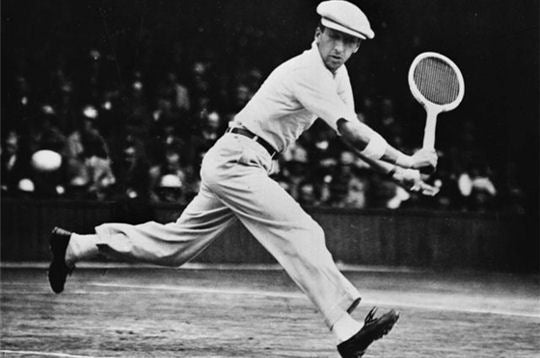René Lacoste: The Tennis Maverick Who Redefined Greatness
16 December 2023 ambikataylors@gmail.com
In the pantheon of tennis legends, René Lacoste stands as a timeless icon, not only for his unparalleled achievements on the court but also for the indomitable spirit and innovation he brought to the game. Often hailed as one of the “Four Musketeers” of French tennis during the 1920s, Lacoste’s journey transcends the boundaries of sportsmanship, leaving an indelible mark on the sport he loved. This article delves into the life and legacy of tennis great René Lacoste, exploring the facets that made him a maverick in the world of tennis and a symbol of excellence.
Table of Contents
ToggleEarly Life and Rise to Tennis Stardom:
Born on July 2, 1904, in Paris, France, René Lacoste exhibited his sporting prowess from an early age. The son of a wealthy industrialist, Lacoste honed his skills on the family estate’s tennis court. At just 15, he made a splash in the tennis world by winning the French Open boys’ title, foreshadowing the greatness that would follow.
Lacoste’s breakthrough on the international stage came in 1925 when, alongside his compatriots Henri Cochet, Jean Borotra, and Jacques Brugnon, he helped France secure its first Davis Cup. This marked the beginning of the famed “Four Musketeers,” a moniker that would resonate throughout tennis history.
Innovations in Tennis Apparel:
Beyond his achievements on the court, Lacoste left an enduring legacy in the realm of tennis fashion. Frustrated by the restrictive and uncomfortable tennis attire of the time, he set out to revolutionize the sport’s clothing. Lacoste designed a short-sleeved, loosely-knit shirt made from a breathable fabric – a precursor to the modern polo shirt.
The innovation did not stop there. Emblazoned with a small crocodile emblem, symbolizing Lacoste’s tenacity on the court, the shirt became an instant sensation. This iconic emblem laid the foundation for the world-renowned Lacoste brand, which has evolved into a global symbol of sophistication and athletic elegance.
Grand Slam Triumphs:
René Lacoste’s prowess on the court is most evident in his Grand Slam victories. Over the course of his illustrious career, he secured seven major singles titles, including two Wimbledon championships (1925, 1928), three French Open titles (1925, 1927, 1929), and two U.S. Open titles (1926, 1927). His playing style was marked by relentless aggression, impeccable technique, and an unwavering mental fortitude that set him apart from his contemporaries.
In 1928, Lacoste achieved the unprecedented feat of winning three Grand Slam titles in a single year – a feat only matched by a select few in the history of tennis. This remarkable accomplishment solidified his status as one of the greatest tennis players of his era.
Davis Cup Dominance:
Lacoste’s contributions to French tennis extended beyond individual triumphs. The “Four Musketeers” dominated the Davis Cup, securing six consecutive titles from 1927 to 1932. René Lacoste’s unwavering commitment to representing his country and the camaraderie shared with his teammates created a legacy that endures in French tennis history.
Retirement and Legacy:
In 1933, at the age of 28, René Lacoste retired from competitive tennis, leaving the sport at the pinnacle of his career. His decision to hang up his racket was driven by a desire to focus on business and family, marking the end of an era in tennis.
Post-retirement, Lacoste’s entrepreneurial spirit flourished as he ventured into the world of fashion. The Lacoste brand, with its iconic crocodile logo, became synonymous with quality and style. Today, the Lacoste brand continues to thrive, embodying the legacy of its founder and his contributions to both tennis and fashion.
Off the Court Contributions:
René Lacoste’s impact transcends his on-court achievements and sartorial innovations. During World War II, he served as a pilot in the French Air Force, demonstrating courage and valor beyond the tennis court. Post-war, he dedicated himself to various philanthropic efforts and remained an influential figure in the global tennis community.
Conclusion:
René Lacoste’s journey from tennis prodigy to global icon is a testament to his exceptional talent, innovation, and sportsmanship. His contributions extend far beyond the court, shaping the very fabric of tennis and fashion. Lacoste’s indomitable spirit, symbolized by the iconic crocodile emblem, continues to inspire generations of athletes and enthusiasts alike, ensuring that the legacy of this tennis maverick endures through the ages.
: Who is René Lacoste, and why is he considered a tennis great? A1: René Lacoste was a French tennis player born on July 2, 1904, in Paris, France. He is considered a tennis great due to his exceptional achievements on the court, including winning seven Grand Slam singles titles and contributing to France’s dominance in the Davis Cup during the 1920s.
Q2: What is René Lacoste’s contribution to tennis fashion? A2: René Lacoste revolutionized tennis fashion by introducing the short-sleeved, breathable polo shirt made from a comfortable knit fabric. The shirt featured a small crocodile emblem, symbolizing Lacoste’s tenacity on the court. This innovation laid the foundation for the iconic Lacoste brand.
Q3: How many Grand Slam titles did René Lacoste win, and in which tournaments? A3: René Lacoste won a total of seven Grand Slam singles titles. He secured two Wimbledon championships (1925, 1928), three French Open titles (1925, 1927, 1929), and two U.S. Open titles (1926, 1927) during his illustrious career.
Q4: What is the significance of the “Four Musketeers” in tennis history? A4: The “Four Musketeers” refers to René Lacoste, Henri Cochet, Jean Borotra, and Jacques Brugnon, a group of French tennis players who dominated the Davis Cup, securing six consecutive titles from 1927 to 1932. They are celebrated for their camaraderie and collective success in representing France in international tennis.
Q5: Why did René Lacoste retire from competitive tennis at the age of 28? A5: René Lacoste retired from competitive tennis in 1933 at the age of 28 to focus on business and family. Despite his relatively early retirement, he left the sport at the pinnacle of his career with numerous achievements, including a historic calendar-year Grand Slam in 1928.
Q6: What is the Lacoste brand, and how did it originate? A6: The Lacoste brand originated from René Lacoste’s innovative tennis shirt design. The brand, known for its iconic crocodile logo, expanded beyond sportswear to become a global symbol of sophistication and athletic elegance. Today, Lacoste is a well-established fashion brand offering a range of products.
Q7: Did René Lacoste contribute to philanthropy and other endeavors after his tennis career? A7: Yes, after his tennis career, René Lacoste contributed to philanthropic efforts and served as a pilot in the French Air Force during World War II. His commitment to various causes and his continued influence in the global tennis community showcase his dedication beyond the tennis court.
Q8: How is René Lacoste remembered in the world of tennis today? A8: René Lacoste is remembered as a tennis legend whose impact extends beyond his on-court achievements. His innovative spirit in both tennis and fashion, along with his contributions to the Davis Cup, continues to inspire athletes and enthusiasts. The Lacoste brand remains a lasting tribute to his legacy.







